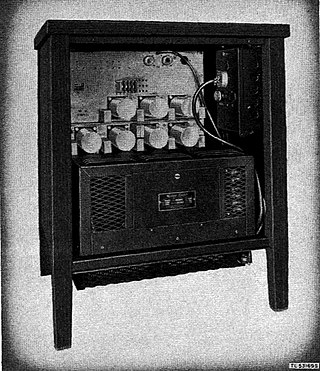Related Research Articles

The Defense Advanced Research Projects Agency (DARPA) is a research and development agency of the United States Department of Defense responsible for the development of emerging technologies for use by the military. Originally known as the Advanced Research Projects Agency (ARPA), the agency was created on February 7, 1958, by President Dwight D. Eisenhower in response to the Soviet launching of Sputnik 1 in 1957. By collaborating with academia, industry, and government partners, DARPA formulates and executes research and development projects to expand the frontiers of technology and science, often beyond immediate U.S. military requirements. The name of the organization first changed from its founding name, ARPA, to DARPA, in March 1972, changing back to ARPA in February 1993, then reverted to DARPA in March 1996.

The National Security Agency (NSA) is an intelligence agency of the United States Department of Defense, under the authority of the Director of National Intelligence (DNI). The NSA is responsible for global monitoring, collection, and processing of information and data for foreign intelligence and counterintelligence purposes, specializing in a discipline known as signals intelligence (SIGINT). The NSA is also tasked with the protection of U.S. communications networks and information systems. The NSA relies on a variety of measures to accomplish its mission, the majority of which are clandestine. The NSA has roughly 32,000 employees.
In computing, Internet Protocol Security (IPsec) is a secure network protocol suite that authenticates and encrypts packets of data to provide secure encrypted communication between two computers over an Internet Protocol network. It is used in virtual private networks (VPNs).
Trusted Computing (TC) is a technology developed and promoted by the Trusted Computing Group. The term is taken from the field of trusted systems and has a specialized meaning that is distinct from the field of confidential computing. With Trusted Computing, the computer will consistently behave in expected ways, and those behaviors will be enforced by computer hardware and software. Enforcing this behavior is achieved by loading the hardware with a unique encryption key that is inaccessible to the rest of the system and the owner.

A secure cryptoprocessor is a dedicated computer-on-a-chip or microprocessor for carrying out cryptographic operations, embedded in a packaging with multiple physical security measures, which give it a degree of tamper resistance. Unlike cryptographic processors that output decrypted data onto a bus in a secure environment, a secure cryptoprocessor does not output decrypted data or decrypted program instructions in an environment where security cannot always be maintained.

TEMPEST is a U.S. National Security Agency specification and a NATO certification referring to spying on information systems through leaking emanations, including unintentional radio or electrical signals, sounds, and vibrations. TEMPEST covers both methods to spy upon others and how to shield equipment against such spying. The protection efforts are also known as emission security (EMSEC), which is a subset of communications security (COMSEC). The reception methods fall under the umbrella of radiofrequency MASINT.

Onion routing is a technique for anonymous communication over a computer network. In an onion network, messages are encapsulated in layers of encryption, analogous to the layers of an onion. The encrypted data is transmitted through a series of network nodes called "onion routers," each of which "peels" away a single layer, revealing the data's next destination. When the final layer is decrypted, the message arrives at its destination. The sender remains anonymous because each intermediary knows only the location of the immediately preceding and following nodes. While onion routing provides a high level of security and anonymity, there are methods to break the anonymity of this technique, such as timing analysis.
Multilevel security or multiple levels of security (MLS) is the application of a computer system to process information with incompatible classifications, permit access by users with different security clearances and needs-to-know, and prevent users from obtaining access to information for which they lack authorization. There are two contexts for the use of multilevel security.
End-to-end encryption (E2EE) is a private communication system in which only communicating users can participate. As such, no one else, including the communication system provider, telecom providers, Internet providers or malicious actors, can access the cryptographic keys needed to converse. End-to-end encryption is intended to prevent data being read or secretly modified, other than by the true sender and recipient(s). The messages are encrypted by the sender but the third party does not have a means to decrypt them, and stores them encrypted. The recipients retrieve the encrypted data and decrypt it themselves. Because no third parties can decipher the data being communicated or stored, for example, companies that provide end-to-end encryption are unable to hand over texts of their customers' messages to the authorities.
The red/black concept, sometimes called the red–black architecture or red/black engineering, refers to the careful segregation in cryptographic systems of signals that contain sensitive or classified plaintext information from those that carry encrypted information, or ciphertext. Therefore, the red side is usually considered the internal side, and the black side the more public side, with often some sort of guard, firewall or data-diode between the two.

Peiter C. Zatko, better known as Mudge, is an American network security expert, open source programmer, writer, and hacker. He is currently the chief information officer of DARPA. He was the most prominent member of the high-profile hacker think tank the L0pht as well as the computer and culture hacking cooperative the Cult of the Dead Cow.
The Defense Data Network (DDN) was a computer networking effort of the United States Department of Defense from 1983 through 1995. It was based on ARPANET technology.

The Disruptive Technology Office (DTO) was a funding agency within the United States Intelligence Community. It was previously known as the Advanced Research and Development Activity (ARDA). In December 2007, DTO was folded into the newly created IARPA.
The Worldwide Military Command and Control System, or WWMCCS, was a military command and control system implemented for command and control of the United States Department of Defense. It was created in the days following the Cuban Missile Crisis. WWMCCS was a complex of systems that encompassed the elements of warning, communications, data collection and processing, executive decision-making tools and supporting facilities. It was decommissioned in 1996 and replaced by the Global Command and Control System.

Trusted Computer System Evaluation Criteria (TCSEC) is a United States Government Department of Defense (DoD) standard that sets basic requirements for assessing the effectiveness of computer security controls built into a computer system. The TCSEC was used to evaluate, classify, and select computer systems being considered for the processing, storage, and retrieval of sensitive or classified information.

Lightweight Portable Security (LPS) or Trusted End Node Security (TENS) was a Linux LiveCD (or LiveUSB) distribution. The application Encryption Wizard, originally bundled with TENS is still actively maintained. LPS and its successor TENS was developed and publicly distributed by the United States Department of Defense’s Air Force Research Laboratory The live CD is designed to serve as a secure end node. The Air Force Research Laboratory actively maintained LPS and TENS from 2007 to 2021. It can run on almost any x86_64 computer (PC or Mac). LPS boots only in RAM, creating a pristine, non-persistent end node. It supports DoD-approved Common Access Card (CAC) readers, as required for authenticating users into PKI-authenticated gateways to access internal DoD networks.

Bullrun is a clandestine, highly classified program to crack encryption of online communications and data, which is run by the United States National Security Agency (NSA). The British Government Communications Headquarters (GCHQ) has a similar program codenamed Edgehill. According to the Bullrun classification guide published by The Guardian, the program uses multiple methods including computer network exploitation, interdiction, industry relationships, collaboration with other intelligence community entities, and advanced mathematical techniques.

The ITT 465L Strategic Air Command Control System was a Cold War "Big L" network of computer and communication systems for command and control of Strategic Air Command "combat aircraft, refueling tankers, [and] ballistic missiles". International Telephone and Telegraph was the prime contractor for Project 465, and SACCS had "Cross Tell Links" between command posts at Offutt AFB, March AFB, & Barksdale AFB (SACCS also communicated with the Cheyenne Mountain Complex and Air Force command posts. The 465L System included IBM AN/FSQ-31 SAC Data Processing Systems, Remote and Simplex Remote Communication Systems, SAC Network Control Office, "4-wire, Schedule 4, Type 4B alternate voice-data operation", and one-way communication with "ICBM launch control centers" In addition to IBM for the "Super SAGE type computers", another of the 6 direct subcontractors was AT&T,

Salvatore J. Stolfo is an academic and professor of computer science at Columbia University, specializing in computer security.

The ARPANET pioneered the creation of novel encryption devices for packet networks in the 1970s and 1980s, and as such were ancestors to today's IPsec architecture, and High Assurance Internet Protocol Encryptor (HAIPE) devices more specifically.
References
- ↑ Weissman, Clark (1992). "BLACKER: security for the DDN examples of A1 security engineering trades". Proceedings 1992 IEEE Computer Society Symposium on Research in Security and Privacy. pp. 286–292. doi:10.1109/RISP.1992.213253. ISBN 0-8186-2825-1. S2CID 6825365.
- ↑ Weissman, Clark (1995-01-24). "Handbook for the Computer Security Certification of Trusted Systems". Archived from the original on 2012-12-12. Retrieved 2007-12-02.
- ↑ Sidney G. Reed, Richard H. Van Atta, and Seymore J. Deitchman (1990). "DARPA Technical Accomplishments: An Historical Review of DARPA Projects" (PDF). 1. IDA Paper P-2192: 20-18–20-20. Archived (PDF) from the original on July 18, 2019.
{{cite journal}}: Cite journal requires|journal=(help)CS1 maint: multiple names: authors list (link) - ↑ Pike, John (2000-02-11). "BLACKER, an article at the Intelligence Resource Program" . Retrieved 2007-12-02.
- ↑ Steve Kent (1996-06-19). "Re: Network Layer Encryption History and Prior Art". ipsec mailing list.